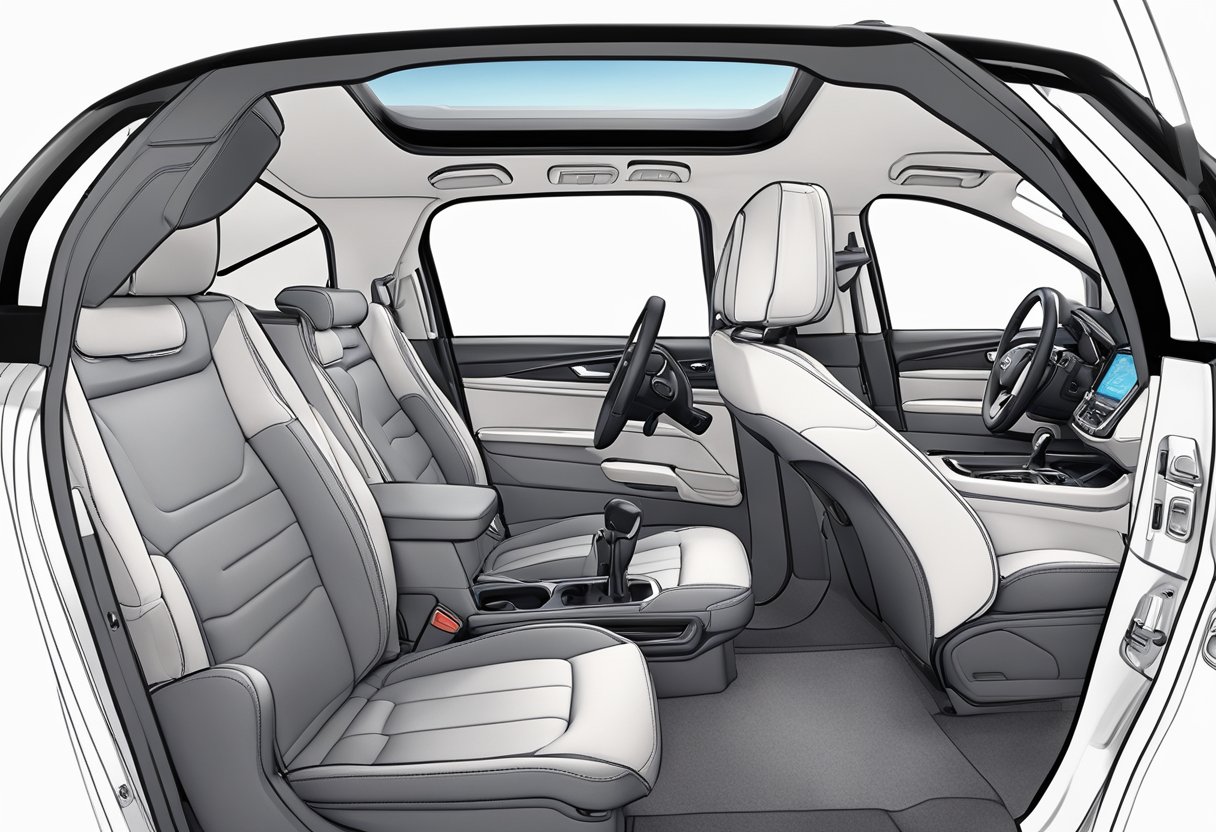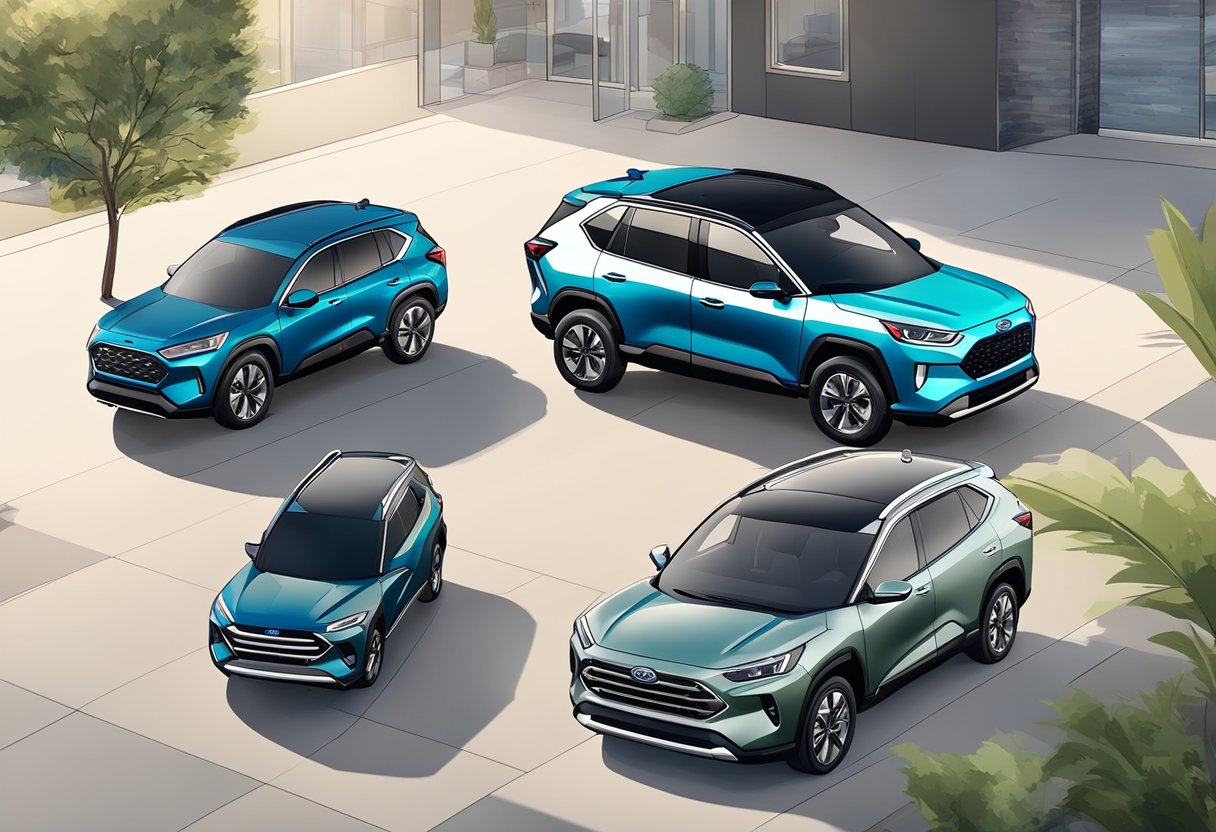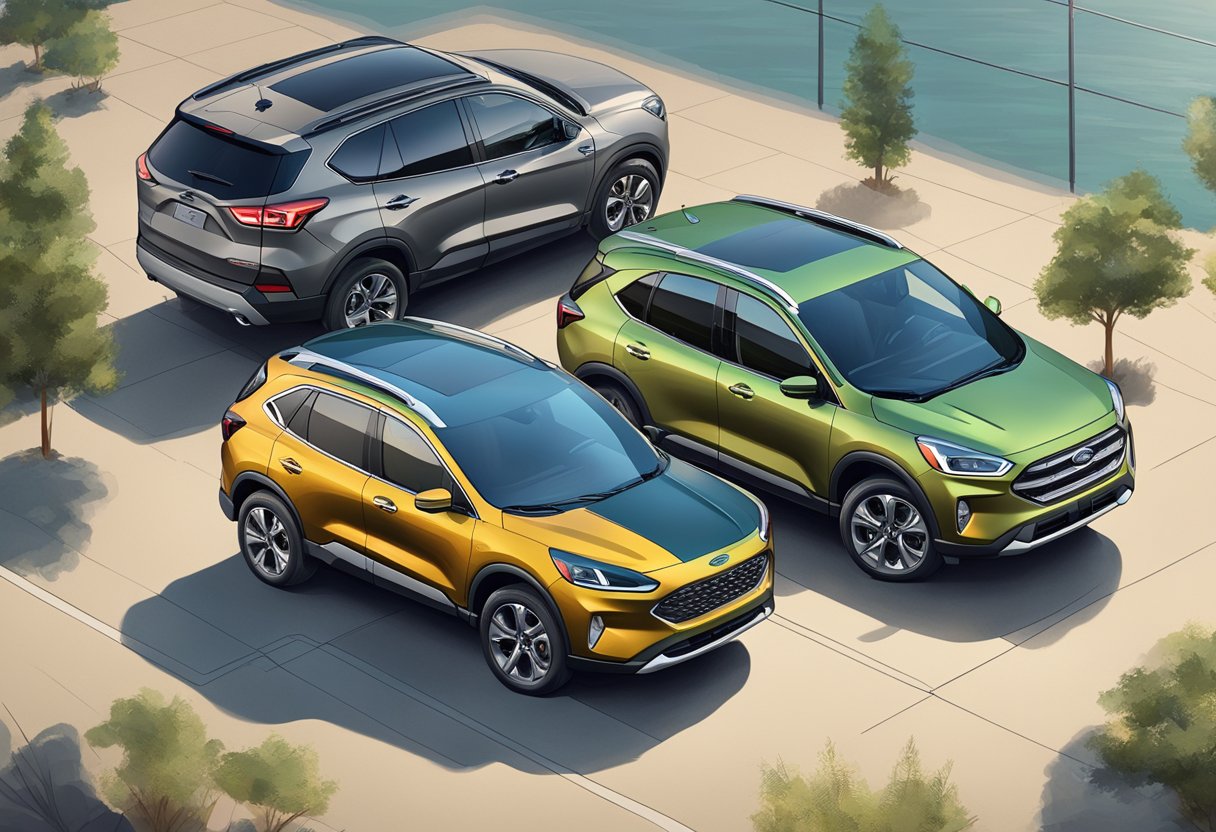*This post may contain affiliate links. As an Amazon Associate we earn from qualifying purchases.
When considering the purchase of a plug-in hybrid SUV, potential buyers often find themselves comparing two of the most competitive models on the market: the Ford Escape PHEV and the Toyota RAV4 Prime. These two vehicles lead their segment, offering a blend of electric-only driving range, fuel efficiency, and the practicality of traditional SUVs. Consumers looking for an eco-friendly option that doesn’t sacrifice space or capability will find much to consider in both models.

The Ford Escape PHEV emphasizes its eco-conscious identity with a significant electric-only range, allowing for shorter trips to be made without using any gasoline. On the other hand, the Toyota RAV4 Prime is recognized for its more powerful hybrid system, delivering superior system power that caters to both performance and efficiency enthusiasts. Each vehicle presents a unique package of interior comforts, safety features, and design aesthetics that cater to a wide array of preferences.
Key Takeaways
- Both the Ford Escape PHEV and the Toyota RAV4 Prime offer impressive electric-only range and overall fuel efficiency.
- The RAV4 Prime boasts a higher system power output, catering to drivers who prioritize performance.
- Each model features distinct safety, interior, and design qualities that cater to a broad audience.
Overview of Ford Escape PHEV and Toyota RAV4 Prime
https://www.youtube.com/watch?v=-RHSPocN18c&embed=true
In the race for efficiency and performance, the Ford Escape PHEV and Toyota RAV4 Prime stand out in the compact crossover category. Each offers a unique blend of electric-only range, hybrid functionality, and a suite of features attractive to the modern driver.
What Is a Plug-In Hybrid?
A plug-in hybrid (PHEV) combines a traditional internal combustion engine with an electric motor and a rechargeable battery. This configuration allows for:
- Driving short distances using only electric power.
- Longer journeys using the combined effort of the engine and electric motor.
- Reduced fuel consumption and emissions compared to conventional vehicles.
Compact Crossover Segment
Compact crossovers are essentially the blend between a sedan’s comfort and an SUV’s capabilities, offering:
- Enhanced cargo space and a higher driving position than a typical sedan.
- More convenience for daily commutes and adequate performance for light off-road excursions.
Ford Escape PHEV:
- Offers a blend of utility and fuel efficiency.
- Features an electric-only mode that reduces reliance on gasoline.
Toyota RAV4 Prime:
- Delivers substantial electric-only range, making it one of the leaders in the segment for battery range.
- Combines power with efficiency, promising an exhilarating driving experience alongside fuel economy.
These models mark significant milestones in the evolution of the SUV, embracing the environmental needs and technological advancements of the times. They cater to those seeking the versatility of a crossover without wanting to compromise on efficiency and eco-friendly attributes.
Power and Performance
https://www.youtube.com/watch?v=sQ4P0qyf6vI&embed=true
When it comes to the power and performance of the Toyota RAV4 Prime and the Ford Escape PHEV, there’s much to compare ranging from the engine’s output to how quickly they can accelerate. Both are plug-in hybrid electric vehicles (PHEVs) that offer a blend of electric efficiency with traditional engine power.
Engine Specifications
Toyota RAV4 Prime
- Powertrain: 2.5L 4-cylinder engine combined with electric motors
- Total System Horsepower: 302 hp
- Drivetrain: All-Wheel Drive (AWD)
Ford Escape PHEV
- Powertrain: 2.5L 4-cylinder engine with electric motor
- Total System Horsepower: 210 hp
- Drivetrain: Front-Wheel Drive (FWD)
Acceleration and Top Speed
Both the RAV4 Prime and the Escape PHEV boast impressive performance figures that highlight their capabilities beyond just fuel efficiency:
- The RAV4 Prime can reportedly zoom from 0 to 60 mph in roughly 5.8 seconds.
- The Escape PHEV takes a longer sprint to reach 60 mph from a standstill, around 9.0 seconds according to sources.
Handling and Drive Types
Tackling different terrains or weather conditions? Here’s what you need to know about handling and drive types:
- Toyota RAV4 Prime offers AWD, giving it an edge in traction and stability, particularly in challenging conditions.
- Ford Escape PHEV maintains a FWD setup, which is generally adequate for daily driving but may not have the same grip as AWD in slick situations.
These plug-in hybrids sure bring zest and practicality into the conversation with their advanced powertrains and spirited performance. Whether it’s the alluring acceleration of the RAV4 Prime or the respectable efficiency the Escape PHEV churns out, there’s no mistaking that PHEVs have shifted into a higher gear of driving excitement.
Range and Efficiency
https://www.youtube.com/watch?v=3fok4TaDRhc&embed=true
When comparing the Ford Escape PHEV and the Toyota RAV4 Prime, it’s important to consider how far they can travel on electric power alone, their overall fuel economy when using hybrid mode, and the practicality of their charging needs.
Electric Range Capabilities
The all-electric range of a plug-in hybrid vehicle is a crucial factor for many buyers. Here’s how the two vehicles stack up:
- Toyota RAV4 Prime: Offers an electric range of approximately 42 miles, though some tests have seen up to 46 miles.
- Ford Escape PHEV: Provides an electric range that is typically around 39 miles.
In the context of daily commuting, both vehicles offer ample electric range to cover average driving distances without tapping into gasoline reserves.
Hybrid Fuel Economy
Once the battery is depleted, the vehicles operate as traditional hybrids, relying on their gasoline engines and regenerative braking to optimize fuel economy. Take a look at their efficiency:
- Toyota RAV4 Prime: Estimated to deliver 90 mpg-e (miles per gallon gasoline-equivalent) combined.
- Ford Escape PHEV: Specific mpg-e figures are less commons, but it is designed for efficiency in hybrid mode,
Both the RAV4 Prime and the Escape PHEV showcase the benefits of hybrid technology by offering fuel savings over traditional gasoline vehicles, particularly in stop-and-go traffic where regenerative braking is most effective.
Charging Infrastructure
Charging times can greatly influence the convenience of owning a plug-in hybrid. Here’s a brief overview:
Toyota RAV4 Prime Charging:
- Standard 3 kW charger
- Available 6.6 kW option that can reduce charging times
Ford Escape PHEV Charging:
- Recharges fully in approximately 3.3 hours on a Level 2 charger
- Likely has an onboard charger less than 4 kW, slower than the upgraded RAV4 Prime charger
For users with access to a 240-volt Level 2 charger, both vehicles can be charged conveniently overnight, ensuring a full battery each morning. However, the RAV4 Prime offers a faster charging option for those who opt for the higher capacity charger.
Interior and Comfort

When considering the Ford Escape PHEV and Toyota RAV4 Prime, the interior and comfort are crucial for those long drives or daily commutes. Let’s check out their cabin dimensions, seating comfort, and tech features to see which might better suit your needs.
Cabin Dimensions and Seating
The Ford Escape PHEV offers a spacious retreat with ample legroom and headroom. Passengers enjoy:
- Front Legroom: Generous space for the driver and front passenger to stretch out.
- Rear Legroom: Comfortable for adults on those longer trips.
- Headroom and Shoulder Room: Sufficient for a sense of openness, even for taller individuals.
In comparison, the RAV4 Prime also provides a pleasant interior environment with:
- Front Legroom: Comparable to the Escape, ensuring a relaxing journey.
- Rear Legroom: Adequate for passengers, although somewhat less than the Escape.
- Cargo Volume: The RAV4 Prime boasts impressive cargo space, making it easier to haul luggage or shopping items.
Both vehicles offer a serene atmosphere, but for those prioritizing cargo volume, the RAV4 Prime has an edge, while the Escape shines in passenger space.
Infotainment and Connectivity
Today’s drivers expect a certain level of tech in their ride, and both of these vehicles deliver:
Ford Escape PHEV:
- Infotainment: Central touch screen offering intuitive navigation through menus.
- Connectivity: Supports both Apple CarPlay and Android Auto for seamless smartphone integration.
Toyota RAV4 Prime:
- Infotainment: Equipped with a responsive system and user-friendly interface.
- Connectivity: Includes Apple CarPlay and Android Auto, ensuring all passengers can connect their devices with ease.
Both models also come standard with features like power windows and power door locks, contributing to the overall convenience factor.
In essence, whether you lean towards the Ford Escape PHEV or the Toyota RAV4 Prime, each promises a comfortable ride with modern touches to keep you and your passengers connected and content.
Safety and Security

When it comes to the Ford Escape PHEV and the Toyota RAV4 Prime, safety is a top priority for both. They are equipped with a suite of driver-assist features and have undergone rigorous crash testing to ensure the security of passengers.
Driver-Assist Features
Ford Escape PHEV:
- Adaptive Cruise Control: Keeps a set distance from the car ahead.
- Pre-Collision Assist: Alerts drivers and applies brakes in case of an imminent crash.
Toyota RAV4 Prime:
- Toyota Safety Sense: An advanced package including adaptive cruise control.
- Lane Departure Alert: Notifies the driver when the vehicle is leaving its lane.
These features help make both vehicles safer on the road, with systems designed to prevent accidents before they happen.
Crash Test Ratings
Both vehicles have been subjected to crash tests by organizations like the National Highway Traffic Safety Administration (NHTSA) and the Insurance Institute for Highway Safety (IIHS).
Ford Escape PHEV:
- Earned high ratings from IIHS for crashworthiness.
- NHTSA ratings are solid, contributing to a sense of security.
Toyota RAV4 Prime:
- Also scored high on IIHS tests, boasting good overall safety.
- The NHTSA has given it top-tier safety ratings, reaffirming its structural integrity.
Crash test ratings are critical for evaluating vehicle safety, and both the Escape PHEV and RAV4 Prime stand out with commendable scores.
Design and Dimensions

When considering the Ford Escape PHEV and the Toyota RAV4 Prime, their designs speak volumes about their individual characters as compact crossovers, and dimensions are key in understanding their spatial offering.
Exterior Styling
- The Toyota RAV4 Prime carries a bold, angular design that exudes a more rugged and athletic stance. Its sharp lines and pronounced wheel arches suggest off-road capability and a dynamic presence.
- The Ford Escape PHEV, on the other hand, opts for a sleeker and more streamlined appearance, with softer contours and a more traditional crossover look that resonates with its urban-friendly manner.
Both models offer unique aesthetics that cater to different tastes but remain firmly rooted in the practicality expected from compact crossovers.
Interior Layout and Features
- Inside the RAV4 Prime, one finds a balance of comfort and utility. The cabin is designed with ergonomics in mind, offering a functional layout alongside features like a modern infotainment system and various storage compartments.
- The Escape PHEV presents an interior that focuses on spaciousness and light. The design highlights include the seamless integration of technology and a thoughtful arrangement of controls and features for ease of use.
Their interiors reflect the blend of technology and practicality, offering passengers a refined space complemented by modern conveniences.
Pricing and Value
https://www.youtube.com/watch?v=xGf7jeEuGNs&embed=true
When eyeing up the Ford Escape PHEV and the Toyota RAV4 Prime, savvy shoppers consider pricing and available tax benefits to get the best bang for their buck. Each vehicle brings its own value proposition to the table, with differing starts in pricing and potential savings down the road.
Starting MSRP and Value Proposition
The Ford Escape Plug-in Hybrid Electric Vehicle (PHEV) and Toyota RAV4 Prime are positioned in a competitive market where pricing plays a pivotal role. Here’s what to expect:
- Ford Escape PHEV: Starts at approximately $40,500
- Toyota RAV4 Prime: Higher on the ladder, starting at around $43,090
Buyers should also scope out the respective warranties, as these can impart long-term value:
- Basic Warranty: Both models typically come with a basic warranty, which usually covers 3 years or 36,000 miles, whichever comes first.
Tax Incentives and Credits
Both models may qualify for federal tax credits, which can sweetly slice off a chunk from the initial investment:
- Federal Tax Credit: Qualifying buyers of new PHEVs can receive a federal tax credit which can be substantial. The exact amount varies based on battery size and other factors, but it could potentially cover several thousand dollars.
It’s wise to consult with a tax professional or do a little homework to unravel the specific credits for which your choice of vehicle may be eligible. Remember that these credits can shift with policy changes, so keeping current with the latest tax rules is a smart move.
Environmental Impact
https://www.youtube.com/watch?v=af3DEv_Gww0&embed=true
When considering the Ford Escape PHEV and the RAV4 Prime, their environmental benefits come chiefly from reduced emissions during all-electric driving, thanks to their electric motors and battery capabilities.
Emissions and Zero-Emission Travel
Both the Ford Escape PHEV and Toyota RAV4 Prime offer significant environmental benefits due to their ability to operate in zero-emission modes. Here’s a breakdown of each vehicle’s contribution to a cleaner environment:
Ford Escape PHEV:
- Offers distinct drive modes that emphasize electric propulsion.
- Auto EV mode for automatic switching between electric motor and gas engine based on driving conditions.
- EV Now mode allows driving with the gasoline engine off.
- EV Later mode conserves battery charge for future use.
Toyota RAV4 Prime:
- Combines an efficient electric motor with a gasoline engine.
- Capable of traveling on electric power alone, potentially resulting in zero tailpipe emissions.
Both vehicles are aimed at reducing emissions during city commuting and shorter trips, where they can utilize electric power from their batteries. The presence of electric motors enables both the Escape PHEV and the RAV4 Prime to offer all-electric driving experiences, thereby lowering their overall environmental impact when compared to traditional combustion engine vehicles. Given their plug-in hybrid nature, the greater the distance driven in all-electric mode, the more significant the reduction in emissions.
Brand Reputation and Customer Satisfaction

When considering the Toyota RAV4 Prime and the Ford Escape PHEV, potential buyers often weigh brand reputation and customer satisfaction. These factors are crucial indicators of what one might expect from ownership experiences related to support, reliability, and overall happiness with the vehicle.
Warranty and Reliability
Toyota RAV4 Prime:
- Basic Warranty: Typically offers a 3-year/36,000-mile basic warranty.
- Reliability: Toyota has a longstanding reputation for reliability, which extends to the RAV4 Prime.
Ford Escape PHEV:
- Basic Warranty: Generally comes with a 3-year/36,000-mile basic warranty similar to the RAV4 Prime.
- Reliability: Ford is known for producing reliable vehicles, though some models have had recalls in the past; the Escape’s reliability is generally well-regarded.
Owner Reviews and Ratings
Toyota RAV4 Prime:
- Owner Reviews: Generally receives high praise for its performance and efficiency.
- Ratings: Often rated well for driving experience, comfort, and value retention.
Ford Escape PHEV:
- Owner Reviews: Owners appreciate its smooth ride and fuel economy.
- Ratings: Typically scores favorably in technology integration and interior design.
Both vehicles are backed by well-established automakers with reputations for creating durable and satisfying vehicles. The warranty terms tend to be competitive, indicating confidence in their products. Owners of the RAV4 Prime and the Escape PHEV frequently express satisfaction, citing their vehicles’ performance and features, but the best choice will differ based on individual priorities and preferences.
Frequently Asked Questions

In choosing between the 2023 Ford Escape PHEV and the RAV4 Prime, prospective buyers often have questions. Let’s dive into some of the most common inquiries to aid in making an informed decision.
What are the main differences between the 2023 Ford Escape Hybrid and RAV4 Prime?
- The RAV4 Prime generally offers more power and all-wheel drive.
- The Ford Escape PHEV provides a more traditional hybrid experience with front-wheel drive.
How do the prices compare for the Ford Escape PHEV and the RAV4 Prime?
- Base models of the Ford Escape PHEV often start at a lower price point than the RAV4 Prime.
- Higher trim levels and additional features can narrow this price gap.
Can I get a tax credit with the purchase of a RAV4 Prime or Ford Escape PHEV?
- Yes, both vehicles may qualify for federal tax credits.
- Exact credit amounts can depend on the specific model year and the owner’s tax situation.
Which has a better fuel economy, the Ford Escape PHEV or the RAV4 Prime?
- The RAV4 Prime boasts impressive mpg-e figures, often higher than the Escape PHEV.
- Real-world driving can affect these estimates, so individual mileage may vary.
What are the cargo space differences between the RAV4 Prime and the Ford Escape?
- The RAV4 Prime offers a spacious cargo area, competitive within its class.
- The Ford Escape PHEV also provides ample cargo space, with little compromise despite its battery placement.
Are there any significant performance differences between the RAV4 Prime and the Ford Escape PHEV?
- The RAV4 Prime tends to be quicker, with a robust acceleration profile.
- The Ford Escape PHEV focuses on efficiency and offers a more composed driving experience.
